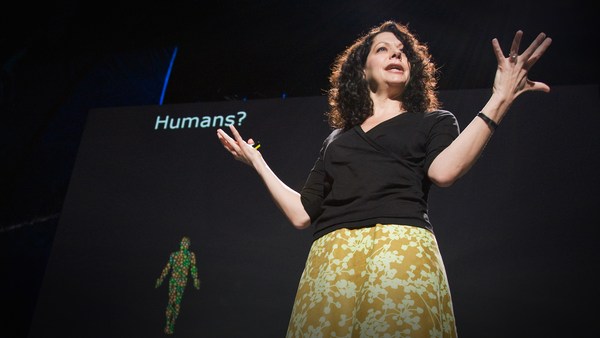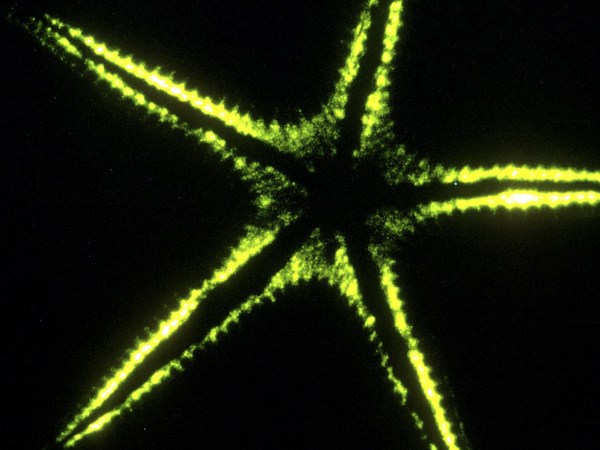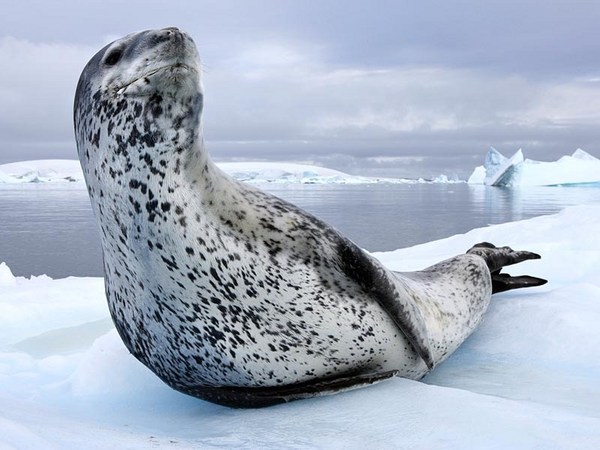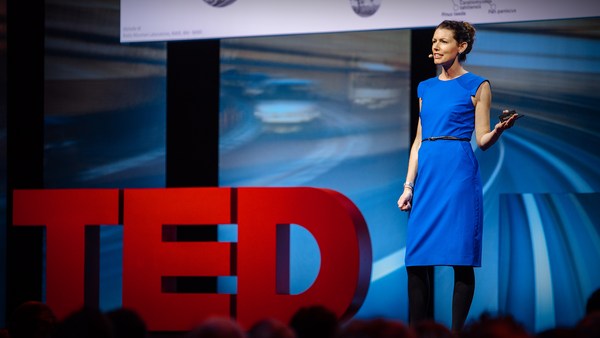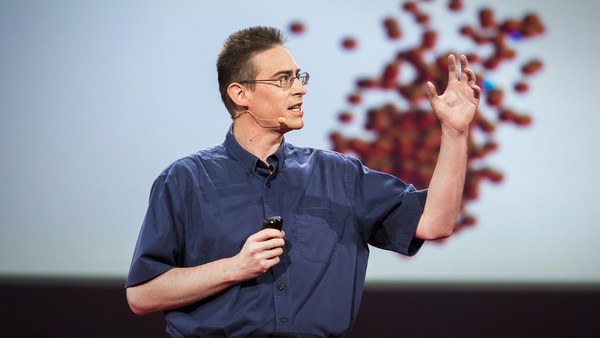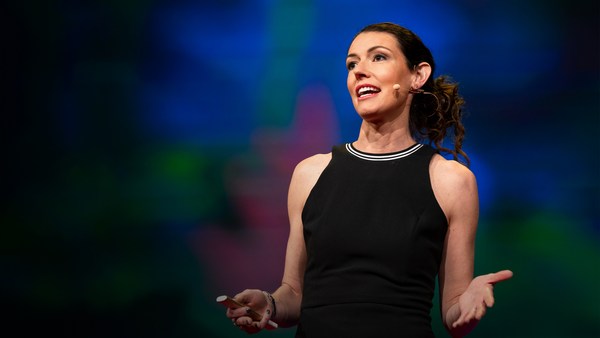In the next ten minutes, we will immerse ourselves in an amazing and beautiful marine world that's very often overlooked. I'd like to take you on a journey into the sea, looking at it from the perspective of its smallest inhabitants: the microbes. My goal is that after this short journey, you'll share my amazement at how deeply connected our lives are to these microscopic creatures and also perhaps my concern that these relationships are often neglected when it comes to making decisions and policies about our oceans.
When you look out on a clear blue ocean, you're actually gazing at a microbial soup full of vibrant life. What you see here are marine bacteria buzzing about and exploring other members of the marine food web. To emphasize how small this world really is, I've added a white line to most of my slides that shows you the thickness of a single strand of human hair -- very tiny. An average teaspoon of clean seawater has five million bacteria and 50 million viruses in it. If I were to scoop up two gallons of seawater, there would be more bacteria in those two gallons than there are people on this planet. Take just a moment and think about how many gallons might make up an ocean. Or maybe I've already made your stomach turn, as you think of all of the seawater we've each accidentally swallowed over the years. But luckily, we rarely get sick from that seawater, because most marine microbes are working for us, not against us.
One of my favorite examples is that they provide half of the oxygen we breathe. In middle school, we all learn to thank the trees. And admittedly, they may be more huggable than the microbes. But it turns out that land plants only create a quarter of the oxygen we breathe. Another quarter comes from macroalgae like kelp and a full 50% from the microbes. Take a deep breath in. Thank the trees. Take another deep breath in. Thank the macroalgae. Your next two breaths -- tip your hats to the microbes.
This picture is of a bacterium that happens to be the single most abundant photosynthesizer on our planet. It's called, "Prochlorococcus," and this is oceans' oxygen-producing powerhouse and, I might argue, one of the most amazing discoveries of recent marine microbiology. We didn't know it existed until 1988. All of human history has depended on this little microbe for the oxygen they breathe every day, no matter where or when they lived. And we've only been aware of that relationship for a mere 24 years. I find that astounding. How many more critical relationships are out there that we have yet to discover?
I see our relationship with marine microbes as parallel in many ways to the relationship we have with microbes in our gut. We've all experienced the wrath of unhappy gut microbes at one point or another, perhaps food poisoning or tainted water. But we may be less aware of the connection we have with marine microbes and the physical discomforts we can feel when those communities change. As an extreme example: the disease cholera is caused by a bacterium that thrives in the ocean. So while most marine microbes are indeed helping us, there do remain plenty that are not. Our relationship with the ocean, much like our gut, is dependent on the right balance of microbes. The old phrase, "You are what you eat" applies to our ocean microbes as well.
To give you a sense of what an overfed ocean may look like, here are two examples of me sampling seawater. On your left, it's a clean coral reef, and on your right is a nearly dead coral reef that has a very intense fish farming operation in the waters there. You'll notice I'm only smiling in one of these two pictures, and in the other one my dive buddy had to be a whole lot closer to capture that image. So if we were to take a drop of seawater from each of these samples and put it under the microscope, this is what the bacteria and viral communities would look like. So again, clean reef on your left, fish farm reef on your right. As we all have had a feeling of discomfort from imbalanced gut microbes, a fish swimming through a part of the ocean that has been overfed in this way -- in this case, by intense aquaculture, but it could be a sewage spill or fertilizer runoff or any number of other sources -- that fish will feel the physical discomforts of the ocean microbes being out of whack. There may be less oxygen present, there may be more pathogens there, and there may be toxins produced by some of these microbes. The bottom line is that from their tiny-scale existence, these tiny microbes have a very large-scale power to control how our ocean smells, how it tastes, how it feels and how it looks.
If you take one idea away from my talk today, let it be this: we have an incredibly important relationship with these marine microbes that have very large-scale consequences, and we're just barely beginning to understand what that relationship looks like and how it may be changing. Just as a physician will have trouble curing a disease of unknown cause, we will have similar trouble restoring ocean health without understanding the microbes better. They are the invisible engineers that control the chemistry of the ocean and therefore, what creatures can live there, whether or not it's safe for us to swim there and all of the other characteristics we sense with our eyes, noses and taste buds. And the more we pay attention to these small but very numerous members of the ocean, the more we're learning they do indeed respond to human actions, such as in this fish farm example.
Now, as the past few slides about coral reefs may have suggested, I do indeed spend much of my time as a researcher thinking about human-microbe interactions, specifically on coral reefs. It turns out, we're not alone in having our own protective community of microbes. Corals, along with most other organisms on this planet, have their own protective communities as well. However, rather than keeping theirs on the inside as we do in our gut, they keep theirs on the outside, to protect them from their surroundings So what you're seeing here is a three-dimensional image of a live spot on a living coral with all of its living bacteria, that I took with some exciting technology -- a high-speed laser-scanning confocal microscope. All of the red circles are the symbiotic algae that live inside the coral tissue, turning sunlight and into sugars they both can use, and all of the little blue dots are the protective bacteria. So when I use image analysis software to highlight the outer layer of the coral in white, you can see that there are still some tiny little blue dots above that layer. And those bacteria are sitting in a mucus layer, which is also part of the coral's protective layer.
From the bigger perspective, I spend my time thinking about these relationships, because too many reefs are going from looking like the picture on your left to the picture on your right. Believe it or not, the picture on your right remains a very popular tourist snorkeling spot on the island of Maui, even though it's lost most of its coral cover over the past decade or so. Corals are getting sick all around the globe at alarming rates, and we really don't know how or why. I see the microbes on the coral reefs, both the good ones and the bad ones, trying to link their micro-scale behaviors to this big picture of: How do we help the reef that looks like the right back towards something that looks more like the left? Or: How do we stop coral disease from spreading?
Just over a year ago, no one had ever seen a view like this. This video is a prime example of making the invisible visible. We're looking at a side view of the same coral as before, where the protective layer meets the seawater; so, seawater on your right, coral on your left. It's incredibly exciting to me that we can finally see these bacteria in real life, in real time, at their micro scale, and learn how they interact with the world around them. Ecologists all over the world are used to being able to grab a pair of binoculars and go out and observe what their study creatures do each day. But microbial ecologists have desperately needed breakthroughs in technology, such as with this fast confocal, to make similar observations. I work to find ways that cutting-edge technologies like this can help make the unseen seeable, to see marine bacteria in action and learn how they behave. In doing so, we can learn how they respond to our actions and our behaviors and the environment around them in ways that will help us better manage our oceans.
Another example of how I'm doing this is by using microfluidics to study specifically how pathogens behave in the ocean. The basic idea behind microfluidics is that you can use nanofabrication techniques to recreate or mimic the conditions bacteria experience at their own tiny scale in the ocean. What you see here is a microfluidic chamber on a microscope slide with a microscope lens underneath it. We use high-speed video microscopy to record bacteria behavior. The colored tubing is where bacteria and seawater flow in and out of the device. And it's using a device like this that I recently discovered that a known coral pathogen actually has the ability to sniff around the seawater and hunt for corals. Here's the video of in action. You'll see all of the pathogens which are the tiny green dots on the left start detecting the coral mucus I put on the right side of the channel, and they swim quickly over in that direction and stay there. Up until now, it was thought that a pathogen would need some good luck to find its host in the ocean. But simply by watching and observing, we can learn that these bacteria are very well adapted to seeking out their victims.
These micro-channels are bringing us closer than ever before to understanding how bacteria navigate that big blue ocean. It turns out that this pathogen can even detect the coral mucus when I dilute it 20,000 fold. So these bacteria are very well adapted to hunting down these corals. I'm currently testing different environmental conditions to see what scenarios make this pathogen more or less capable of hunting corals. By learning more about what triggers the hunt, we should be able to find ways to help slow down or prevent this disease. There's also some evidence that the healthy microbes on the coral can fight off the pathogen if the conditions are right.
So, one final image of a coral and its healthy bacteria. I hope you've enjoyed this short journey into our microbial oceans and that the next time you look out at the sea, you'll take in a deep breath of fresh ocean air and wonder: What else are all of the unseen microbes doing to keep us and our oceans healthy?
Thank you.
